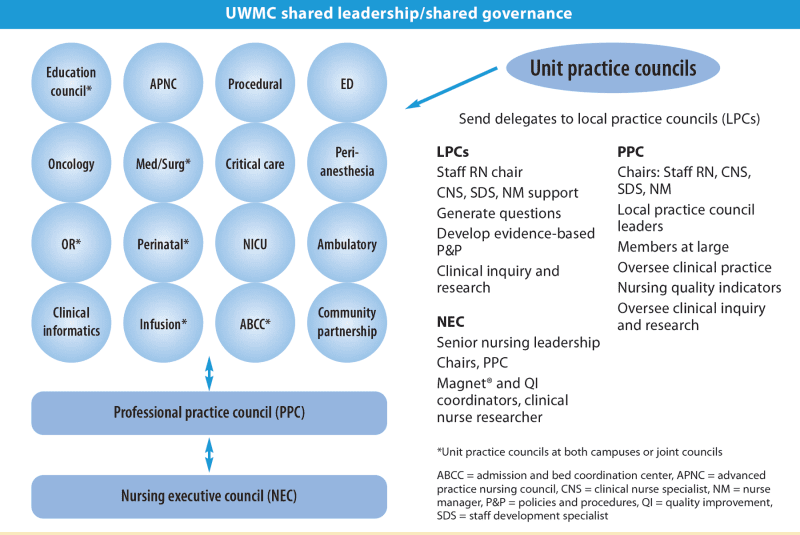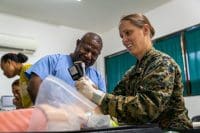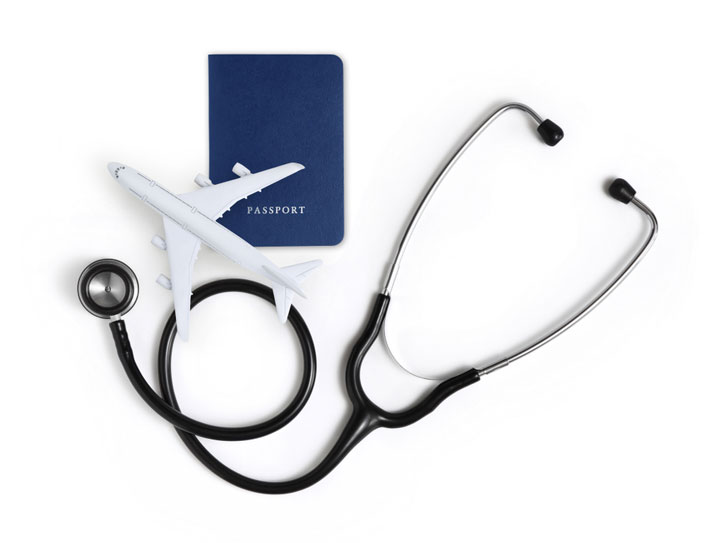Prepare nurses to lead.
- Shared governance structures allow clinical nurses to step into leadership roles away from the inpatient, ambulatory, or direct patient care setting.
- Clinical nurses require training to ensure they feel prepared and confident to lead.
- A workshop and subsequent survey indicate that training increases nurses’ leadership skills and confidence in shared governance roles.
Shared governance provides clinical nurses with a voice and opportunities to engage within an organization. It allows them to step into leadership roles to strengthen the inpatient, ambulatory, or direct patient care units in which they work. Shared decision-making among clinical nurses and nurse leaders promotes active involvement from everyone. In addition, effective shared governance improves patient outcomes and fosters a culture of inquiry and inclusion, which ultimately enhances job satisfaction and retention.
However, clinical nurses require formal training for shared governance leadership positions to ensure they’re prepared to successfully lead meetings, support fellow members, and guide successors. To provide that training, we designed a workshop at the University of Washington Medical Center (UWMC) as a quality improvement project to teach nurses how to serve as contributing members of a council meeting and prepare them to lead in shared governance. UWMC, the first organization to receive American Nurses Credentialing Center (ANCC) Magnet® recognition, uses shared governance to encourage staff to evaluate and update policies and procedures that benefit patient outcomes.
In preparation, we received formal training through the University of Washington Professional and Organizational Development courses. We combined this education with personal experiences to develop and teach the workshop. A similar interactive curriculum developed for physician leaders in an academic medical facility achieved results that suggest the workshop’s benefit in advancing leadership qualities to improve meeting effectiveness.
Workshop design
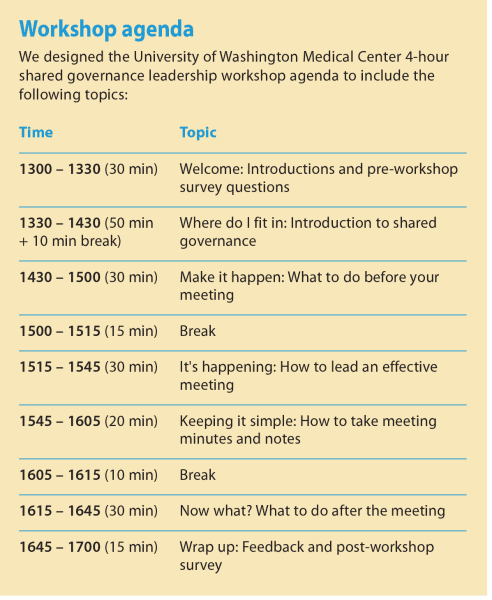

The virtual workshop format included lectures, discussions, group work, and interactive technology, including polls, chat boxes, and breakout rooms. Objectives encompassed gaining knowledge of shared governance, learning to lead a productive meeting, taking meeting minutes, communicating effectively during meetings, and applying enhanced leadership. At the end of the workshop, participants synthesized what they learned in an evolving case scenario. (See Workshop agenda.)
Workshop content
The workshop began with an introduction to shared governance, including UWMC’s shared governance structure, and where each nurse plays a role. At UWMC, the structure begins with several clinical nurses from one unit forming unit practice councils (UPCs). Chairs or delegates from each UPC attend the local practice council (LPC), which consists of a staff RN chair and combines similar UPCs (for example, medical-surgical or critical care). LPC leaders then participate in the professional practice council (PPC), which includes clinical nurse specialists, clinical nurse educators, and nurse managers. Chairs from the PPC serve as members in the nursing executive council, which includes senior nursing leadership. (See Shared governance in action.)
After participants identified where they fit into shared governance, they presented strategies for using bidirectional communication in their roles to move information through the structure from the clinical nurse to the nursing executive council and vice versa. In addition, we introduced participants to the importance of a charter and how to set yearly goals. We encouraged them to create a document outlining council responsibilities, membership expectations, chair expectations, and goals for the upcoming year; they also evaluated whether goals were met from the previous year.
Meeting preparation
Planning for a meeting occurs several weeks in advance to allow ample time for preparation. At UWMC, council chair responsibilities include creating the agenda, which involves identifying and prioritizing topics, determining the length and objectives of each topic, and finding, inviting, and coordinating with speakers. When determining topic objectives, clarify the goal of the presentation with the speaker (for example, request council member action, opinion, or feedback or provide information for update, discussion, or debrief). Share the draft agenda with other co-chairs or leaders for review.


Leading productive meetings
You can facilitate the meeting flow in several ways. During the meeting, communicate with fellow chairs verbally or nonverbally. If nonverbally, devise cues in advance to minimize distractions. Keep track of time as discussions evolve to include all agenda topics. You want to ensure productivity, topic goals are met, and next steps communicated. Allow time for participation, questions, and feedback. However, be aware of various personalities and behaviors and address them early on to help facilitate the meeting flow. (See Meeting tips.)
Meeting minutes provide a paper trail of how projects start and evolve. In addition, others can reference them for projects already completed and use them to build on identified tools and resources. Organizations can pull data from meeting minutes for inclusion in ANCC Magnet and American Association of Critical-Care Nurses’ Beacon Award applications. Use minutes to inform staff and uphold bidirectional communication. Minutes also keep stakeholders informed of project progress and help to maintain transparency. (See Know your audience.)
Select a template (perhaps using the agenda) before the meeting to streamline taking minutes. Establish note-taking rules regarding what to include and exclude. For example, the minutes should consist of action items, decisions, resolutions, and outcomes but not word-for-word discussions, long-winded presentations, opinions, or confidential information. Summaries and attachments can aid dissemination.
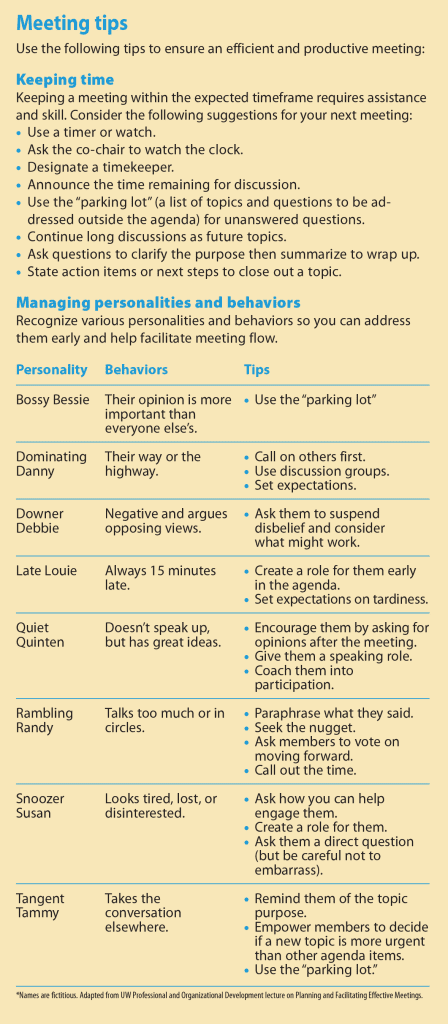

Post-meeting actions
After the meeting, delegate action items using closed-loop communication and ensure follow-up by setting deadlines for various tasks. Time for debriefing among chairs and council leadership allows opportunity to provide feedback, identify strengths or areas for improvement, and make preliminary plans for the next meeting. Share a draft of the meeting minutes with other attendees so they can edit and provide feedback before distribution to a wider audience. To ensure all staff have access to the minutes, publish and archive them on the organization’s website. Also consider sending a message of thanks to the speaker along with any follow-up questions or next steps identified by the group.
Workshop survey results
In December 2020, 37 inpatient and ambulatory nurses (with varying degrees of expertise and comfort in leadership roles) attended the 4-hour workshop. They completed anonymous surveys to assess role confidence before, immediately after, and then 6 months after the workshop; 31 nurses completed the immediate survey, and 15 completed the 6-month survey. The surveys included open-ended questions and several statements that they rated on a 4-point Likert scale (strongly disagree, disagree, agree, or strongly agree).
We performed summary statistics and t tests to calculate mean scores, standard deviations, and P-values. Immediate survey results demonstrated a statistically significant difference with an increase in confidence to lead a productive meeting, take meeting minutes and notes, and effectively communicate during meetings. The results also showed a significant increase in confidence in current leadership skills. The 6-month survey demonstrated continued increase in attendee confidence in these skills.
Survey results demonstrate the workshop’s immediate and sustained effects. In the 6-month post-workshop survey, 93% of the participants who completed the survey agreed or strongly agreed that the workshop should be offered again and that they applied what they learned from the workshop in their practice. (View workshop survey results)
Shared governance leadership workshop survey results
We asked workshop attendees to complete three surveys (pre-workshop, immediately after, and 6 months after) to gauge their confidence levels.
The following figures show results over time:
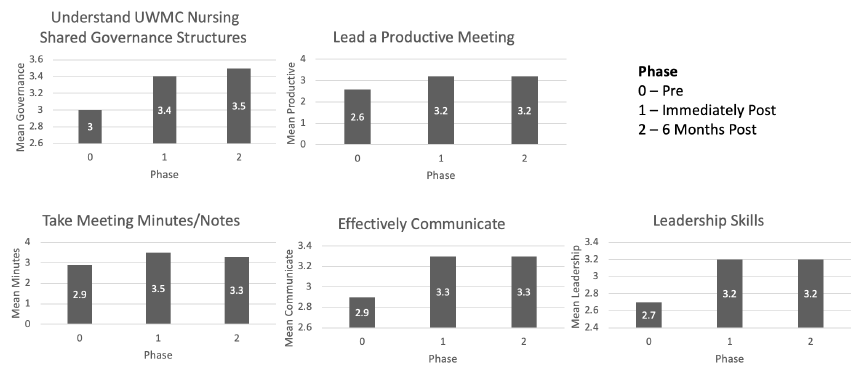

Plans for the future
Limitations of this project include accessibility (attendance required nurses to step away from clinical duties), low participation in the 6-month follow-up survey, and conducting the workshop only once. If the organization decides to offer the workshop again, we will conduct pre- and post-surveys and consider administering follow-up surveys earlier than 6 months to increase participation. We also should compare data between in-person and virtual workshops. In the meantime, new council members, new chairs, and other clinical nurses interested in shared governance can view the recorded workshop as they prepare for leadership roles and responsibilities. We may conduct surveys with those nurses who view the recorded workshop to determine its effectiveness.
Despite these limitations, survey results indicate that this type of workshop can support enhancing nurses’ confidence in their ability to lead council meetings. Implementing a similar project at your organization may provide you with similar outcomes.
Pre-workshop and post-workshop self-assessment
Participants were asked to rate whether they agreed or disagreed with the following statements on a 4-point Likert scale (1 = strongly disagree, 2= disagree, 3 = agree, 4 = strongly agree). Survey results immediately post-workshop demonstrated a statistically significant increase in confidence in skills.


Pre-workshop and 6 months Post-workshop self-assessment
Survey results six months post-workshop demonstrated a statistically significant increase in understanding the shared governance structure and skills confidence.


SEM = standard error mean, STD = standard deviation
The authors work at the University of Washington Medical Center Montlake Campus in Seattle. Marites Almachar is a teaching associate/nurse practitioner. Parisa Sutanthavibul is a STAT/critical care staff nurse and current doctor of nursing practice student expected to graduate in 2025.
References
American Nurses Credentialing Center. Magnet Model—Creating a Magnet culture. October 20, 2017. nursingworld.org/organizational-programs/magnet/magnet-model
LeBlanc LA, Nosik MR. Planning and leading effective meetings. Behav Anal Pract. 2019;12(3):696-708. doi:10.1007/s40617-019-00330-z
McKnight H, Moore SM. Nursing shared governance. StatPearls. September 19, 2022. ncbi.nlm.nih.gov/books/NBK549862
Merriam S, DeKosky A, McNeil M, Donovan A. Avoiding death by meeting: An interactive workshop for academic faculty highlighting strategies to facilitate effective team meetings. MedEdPORTAL. 2021;17:11121. doi:10.15766/mep_2374-8265.11121
Pauley J. Planning and facilitating effective meetings. Lecture presented at University of Washington Professional and Organizational Development; November 25, 2019; Seattle, WA.
University of Washington Medical Center. Culture of inquiry and innovation. UWMC professional practice structure | Our shared leadership. 2023. depts.washington.edu/uwmcnursingreport/ppc
American Nurse Journal. 2024; 19(6). Doi: 10.51256/ANJ0624116
Key words: shared governance, nurse leadership, nurse councils


